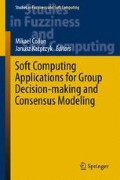Abstract
In this paper we propose Riesz spaces as general framework in the context of pairwise comparison matrices, to deal with definable properties, real situations and aggregation of preferences. Some significant examples are presented to describe how properties of Riesz spaces can be used to express preferences. Riesz spaces allow us to combine the advantages of many approaches. We also provide a characterization of collective choice rules which satisfy some classical criteria in social choice theory and an abstract approach to social welfare functions.
Access this chapter
Tax calculation will be finalised at checkout
Purchases are for personal use only
References
Abramovich Y, Aliprantis C, Zame W (1995) A representation theorem for Riesz spaces and its applications to economics. Econ Theory 5(3):527–535
Aliprantis CD, Brown DJ (1983) Equilibria in markets with a Riesz space of commodities. J Math Econ 11(2):189–207
Aliprantis CD, Burkinshaw O (2003) Locally solid Riesz spaces with applications to economics. Am Math Soc 105
Aliprantis CD, Tourky R (2007) Cones and duality. Am Math Soc 84
Badri MA (1999) Combining the analytic hierarchy process and goal programming for global facility location-allocation problem. Int J Prod Econ 62(3):237–248
Belton V (1986) A comparison of the analytic hierarchy process and a simple multi-attribute value function. Eur J Oper Res 26(1):7–21
Beynon WM (1975) Duality theorems for finitely generated vector lattices. Proc Lond Math Soc 31(3):114–128. Citeseer
Cavallo B, D’Apuzzo L (2009) A general unified framework for pairwise comparison matrices in multicriterial methods. Int J Intell Syst 24(4):377–398
Cavallo B, D’Apuzzo L (2015) Reciprocal transitive matrices over abelian linearly ordered groups: characterizations and application to multi-criteria decision problems. Fuzzy Sets Syst 266:33–46
Cavallo B, Vitale G, D’Apuzzo L (2016) Aggregation of pairwise comparison matrices and Arrow’s conditions. Submitt Fuzzy Sets Syst
Cerreia-Vioglio S, Maccheroni F, Marinacci M, Montrucchio L (2015) Choquet integration on Riesz spaces and dual comonotonicity. Trans Am Math Soc 367(12):8521–8542
Debreu G (1954) Representation of a preference ordering by a numerical function. Decis Process 3:159–165
Di Nola A, Lenzi G, Vitale G (2016) Łukasiewicz equivalent neural networks. In: Advances in neural networks. Springer, pp 161–168
Di Nola A, Lenzi G, Vitale G (2016) Riesz–McNaughton functions and Riesz MV-algebras of nonlinear functions. Fuzzy Sets Syst
Di Nola A, Leuştean I (2014) Łukasiewicz logic and Riesz spaces. Soft Comput 18(12):2349–2363
Frederick S, Loewenstein G, O’donoghue T (2002) Time discounting and time preference: a critical review. J Econ Lit 40(2):351–401
Harsanyi JC (1953) Cardinal utility in welfare economics and in the theory of risk-taking. J Polit Econ 61(5):434–435
Houthakker HS (1950) Revealed preference and the utility function. Economica 17(66):159–174
Hua Lu M, Madu CN, Kuei Ch, Winokur D (1994) Integrating QFD, AHP and benchmarking in strategic marketing. J Bus Ind Mark 9(1):41–50
Labuschagne C, Van Alten C (2007) On the variety of Riesz spaces. Indagationes Mathematicae 18(1):61–68
Levy H, Markowitz HM (1979) Approximating expected utility by a function of mean and variance. Am Econ Rev 69(3):308–317
Mac Lane S (1978) Categories for the working mathematician, vol 5. Springer Science & Business Media
Racioppi V, Marcarelli G, Squillante M (2015) Modelling a sustainable requalification problem by analytic hierarchy process. Qual Quant 49(4):1661–1677
Saaty TL (1977) A scaling method for priorities in hierarchical structures. J Math Psychol 15(3):234–281
Saaty TL (1990) How to make a decision: the analytic hierarchy process. Eur J Oper Res 48(1):9–26
Torrance GW, Feeny DH, Furlong WJ, Barr RD, Zhang Y, Wang Q (1996) Multiattribute utility function for a comprehensive health status classification system: health utilities index mark 2. Med Care 34(7):702–722
Trockel W (1998) Group actions on spaces of preferences and economic applications. Util Funct Ordered Spaces 5:159–175
Vaidya OS, Kumar S (2006) Analytic hierarchy process: an overview of applications. Eur J Oper Res 169(1):1–29
Xu Z (2015) Uncertain multi-attribute decision making: methods and applications. Springer
Zanakis SH, Solomon A, Wishart N, Dublish S (1998) Multi-attribute decision making: a simulation comparison of select methods. Eur J Oper Res 107(3):507–529
Author information
Authors and Affiliations
Corresponding author
Editor information
Editors and Affiliations
Rights and permissions
Copyright information
© 2018 Springer International Publishing AG
About this chapter
Cite this chapter
Di Nola, A., Squillante, M., Vitale, G. (2018). Social Preferences Through Riesz Spaces: A First Approach . In: Collan, M., Kacprzyk, J. (eds) Soft Computing Applications for Group Decision-making and Consensus Modeling. Studies in Fuzziness and Soft Computing, vol 357. Springer, Cham. https://doi.org/10.1007/978-3-319-60207-3_8
Download citation
DOI: https://doi.org/10.1007/978-3-319-60207-3_8
Published:
Publisher Name: Springer, Cham
Print ISBN: 978-3-319-60206-6
Online ISBN: 978-3-319-60207-3
eBook Packages: EngineeringEngineering (R0)

